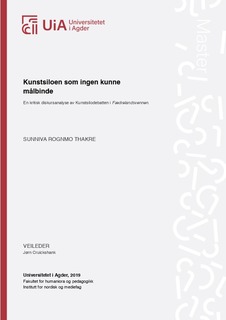| dc.description.abstract | The focus of this thesis is the debate surrounding Kunstsilo, in particular the public debate published through the regional newspaper, Fædrelandsvennen (Friends of the Fatherland).The debate began in 2015, when Nicolai Tangen, a successful hedge fund manager and philanthropist, donated his private collection of contemporary art to the municipality of Kristiansand, Norway’s fifth largest city. The public announcement of this donation identifiedan abandoned silo located on Odderøyathat is part of the city’s seaport, as the collection’s permanent home.Sørlandets Kuntmuseum was granted the right to manage the collection in perpetuity. In 2018, a fierce, public debate beganin the various sections of Fædrelandsvennenbetween champions and opponents of the Kunstsilo project.This thesis uses a discourse analytical approach to the development of the debate, with the purpose of examining how the discussion and debate became so polarized.The data is reviwed both quantitatively and qualitatively. The quantitative survey presents diagrams of Fædrelandsvennens coverage of Kunstsilo over a period of four years, through several articles, thesections of the newspaper where the articles appeared, and the timeframe, particularly in 2018, when most of the articles were published. Norman Fairclough's model for critical discourse analysis is applied to a subsection of the dataqualitatively, including a2015 article and a comment in the newspaper's digital edition from2018, both of which areconsideredcrucial for the newspaper's change in social practice.Sixdiscourses on Kunstsilo are presented, from thenewspaper's opinion section during 2018: 1.the economic discourse 2.the power structure discourse 3.the appropriate use of public funding discourse 4.thecommercial impactdiscourse 5.the cultural impact discourseand, 6.the philosophical discourse. The six discourses are further analyzed in relation to egalitarian and equity-oriented thinking with a moral emphasis on the "popular" in Norwegian society, which in this thesisis defined as social structures. Finally, the six discourses are quantified based on their size, overlap and development over time. This is illustrated through two different diagrams. The findings show that the power structure discourseand the appropriate use of public funding discourseare dominant in both discursive size and in the development of debate over time. | nb_NO |

